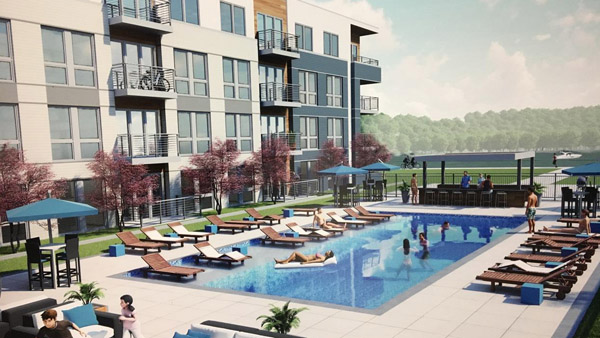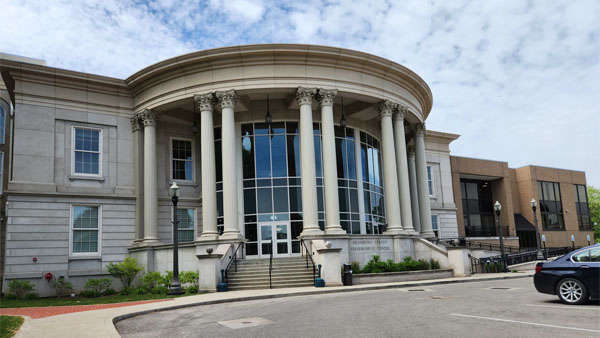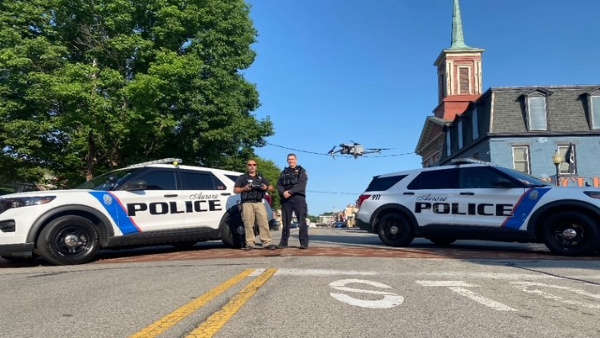Lawrenceburg Common Council members have differing views on how to finance its half of a $30 million riverfront residential development.

A concept design of Flaherty & Collins' proposed 150-unit apartment building to be built on the Ohio River levee on West High Street in Lawrenceburg.
(Lawrenceburg, Ind.) - Lawrenceburg city leaders are still working on a plan to pay for half of a new residential development on the Ohio River levee.
Lawrenceburg Common Council voted unanimously in June to move forward with Indianapolis-based developer Flaherty & Collins to develop a 150-unit apartment building on West High Street. The development could include views of the river for residents, a parking garage, and some retail space.
The city and the developer would likely split the $30 million cost.
Council and Mayor Kelly Mollaun met for a work session on Wednesday, August 1. Mollaun said during the meeting he hoped to have the votes to approve a financing plan, but there was no consensus by the time the meeting ended.
At issue is whether the city should pay cash for the city’s half of the investment, or if part of the project should be bonded.
“We have three options: one is we write a check, the second is we bond part of it and write a check for part of it, and the third is to bond all of it,” he said.
Mollaun said there is approximately $26 million in the city’s MDF fund. Any cash part of the financing would come from that fund.
Councilman Mel Davis asked if the city could consider simply loaning the money to the developer. The mayor said he has been advised that method would subject the city to “way too much exposure.”
Mollaun said he strongly favors a plan to split paying cash and bonding the city’s half of the $30 million, with TIF funding possibly used to pay off the bond. Clerk-Treasurer Rich Richardson indicated that a bond-cash combination would be wise.
Councilman Paul Seymour shared his opinion that the TIF money should not be used. He said the city should pay cash entirely.
“We should be looking at this to be a project that gives back to the community now, not 30 years from now (if TIF money is used). The other part of that is if we finance it, we’re adding to the cost of the project,” Seymour said.
“I’m not a big money person. I’m just a simple guy, but if I got the money to pay for something, I’m going to use my cash because I don’t want to end up paying a whole lot of interest.”
Seymour added that he believes spending cash would not hinder the city from doing other projects.
The mayor followed by saying that writing a $15 million check makes him nervous, but the city does have it.
Councilman Tony Abbott said he worries paying all cash will tie the city’s hands when it comes to other potential projects. He lamented the recent losses of some low-income housing in the city’s downtown.
“I think Lawrenceburg is going to be facing some emergency residency for some lower income people,” Abbott said. “I want this board to kind of commit to bringing in a developer to do some lower income housing somewhere.”
Davis pitched a long view of the city finances in making this decision. He said not completely paying cash would protect the city's coffers and services to residents into the future.
Seymour countered that years of paying interest does not benefit taxpayers.
Ultimately, council member will decide on how the city will finance the project. The funding question could be voted on at city council’s next meeting on Monday, August 6.
Mollaun added that the city is meeting with the Dearborn County Historical Society, headquartered in the Vance-Tousey House next door to the development site, to discuss any concerns they have.
RELATED STORIES:
Lawrenceburg Council Gives Green Light To River Levee Apartment Development
New Lawrenceburg Civic Park Could Lure More Downtown Investment
$30M Apartment Development Could Be Coming To Lawrenceburg's Riverfront

 Dearborn County Comprehensive Plan Public Workshop Planned for July 24
Dearborn County Comprehensive Plan Public Workshop Planned for July 24
 4th of July Celebrations in Eagle Country
4th of July Celebrations in Eagle Country
 Full Day of Fun Scheduled at City of Greendale 4th of July Celebration
Full Day of Fun Scheduled at City of Greendale 4th of July Celebration
 Dearborn Co. 4-H, Clearinghouse Teaming to Fill the Van
Dearborn Co. 4-H, Clearinghouse Teaming to Fill the Van
 Former Washington Township Trustee Arrested for Theft and Official Misconduct
Former Washington Township Trustee Arrested for Theft and Official Misconduct
 Aurora Police Launch New Drone Program
Aurora Police Launch New Drone Program













